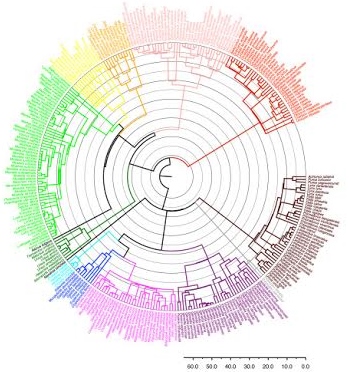Classification
Domain: Eukaryote
Organisms in this domain are characterized by a contained nuclei and membrane bound organelles.
Kingdom: Animalia
Every animal will fall under the Animalia kingdom,
meaning that they will all be multicellular and
heterotrophic. There is an estimation of 9 to 10 million
animals that roam the globe. Most animals will be
diploid and will have cells that do not contain a cell
wall (Myers
2001).
Phylum: Chordata
All chordates at some stage in their life had to have a
notochord, which stretches the length of the body for
motion support. Also they will have three tissue layers,
a digestive system, closed circulatory system, bone or
cartilage endoskeleton, and a nerve chord ending with
the brain (Myers
2001).
Class: Mammalia
All mammals share three common characteristics: three
middle ear bones (anvil, hammer, and stirrup), hair, and
mammary glands for milk production. Mammalia may have
common traits, but the diversity is so large that
classifying organisms is extremely difficult. They can
range from a few grams to several tons (Myers
et al. 2005).
Order: Carnivora
There are around 270 species that inhibit this order.
Although there is a common misconception that all
organism in this order are carnivores that is wrong.
There are a variety of organisms that do not feed on
other animals, such as bats, primates, and marsupial
mammals (Poor).
This is a fairly new family that includes skunk and
stink badgers. The stink badger, Mydaus, was just
recently added to this family after molecular research.
Almost all species that are in the Mephitidae family
will have a pattern on the coats, but their most
distinct characteristic is the anal gland that produce
toxic odors to fight off threats. Spotted skunks are the
smallest and the largest is the Hog-nosed skunk. Skunks
and stink badgers are also nocturnal and not very
territorial (Wund
2005).
This phylogenetic tree represents all Carnivores and the orange section include the family of the Spotted Skunk.
Genus: Spilogale
The Spilogale, also known as spotted skunk. There are
five members of the Spilogale genus, Spilogale
putorius, Spilogale pygmae, Spilogale angustifrons,
Spilogale aquaticus, and Spilogale gracilis
(Myers
et al. 2014).
Species: Spilogale putorius
The Spilogale putorius, also known as the eastern spotted skunk, is the smallest skunk in the Spilogale genus. They have unique characteristics compared to its relatives (Myers et al. 2014).
This phylogenetic tree represents the species of Spotted Skunk.
Explanation of Scientific Name (Bullock 2008)-
Spilo: Spot
Gale: Weasel
Putorius: Fetid Odor
To continue exploration, pressed forward to the Habitat page!
May also be of help:

